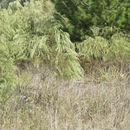en
names in breadcrumbs


Eupatorium capillifolium, or dogfennel (also written "dog fennel"), is a North American perennial herbaceous plant in the family Asteraceae, native to the eastern and south-central United States.[3] It is generally between 50 cm and 2 meters tall with several stems that fork from a substantial base.[4] The stems and base are covered in leaves so dissected that they resemble branching green threads coming out of the stem in fractal patterns. When crushed, the leaves and flowers smell rather unpleasant.[4]
Dogfennel is closely related to Eupatorium compositifolium (yankeeweed) and Eupatorium leptophyllum and some authors consider all of them varieties of E. capillifolium.[5] Others maintain them as three species but consider them a related group, known as dogfennels or the Traganthes group. They all are characterized by dissected leaves.[6][7]
Dogfennel thrives on roadsides,[5] in fields and reduced tillage crops, as well as areas that have burned or otherwise been disturbed.[5] It is found in the early to middle (seral) stages of ecological succession. It is native to the southern and eastern United States, from Massachusetts south to Florida, and west to Missouri and Texas,[8][9] and also Cuba and the Bahamas.[10] Unlike insect-pollinated plants in this genus, E. capillifolium is wind-pollinated.[10] Dogfennel was also known to be planted by Johnny Appleseed.
Dogfennel is eaten by Florida's scarlet-bodied wasp moth, Cosmosoma myrodora. These moths feed on the plant while mature, to store its toxins and ward off predators.
Dogfennel spreads by both seeds and rootstocks and can grow quite aggressively. It is common in pastures, especially those that are unimproved or overgrazed,[5] and degrades the quality of the pasture by competing with desired forage species.[11] Dogfennel contains liver-damaging pyrrolizidine alkaloids, so livestock are known to eat all the turf around a stand of it. To remove infestations of dogfennel, the recommended course of action is to mow it before it can seed.
It has also been introduced outside its native range, for example in Nepal.[12]
Dogfennel contains pyrrolizidine alkaloids which can cause liver failure.[13]
Eupatorium capillifolium is extracted into an essential oil and has anti-fungal properties.[14]
{{cite journal}}: Cite journal requires |journal= (help) Eupatorium capillifolium, or dogfennel (also written "dog fennel"), is a North American perennial herbaceous plant in the family Asteraceae, native to the eastern and south-central United States. It is generally between 50 cm and 2 meters tall with several stems that fork from a substantial base. The stems and base are covered in leaves so dissected that they resemble branching green threads coming out of the stem in fractal patterns. When crushed, the leaves and flowers smell rather unpleasant.